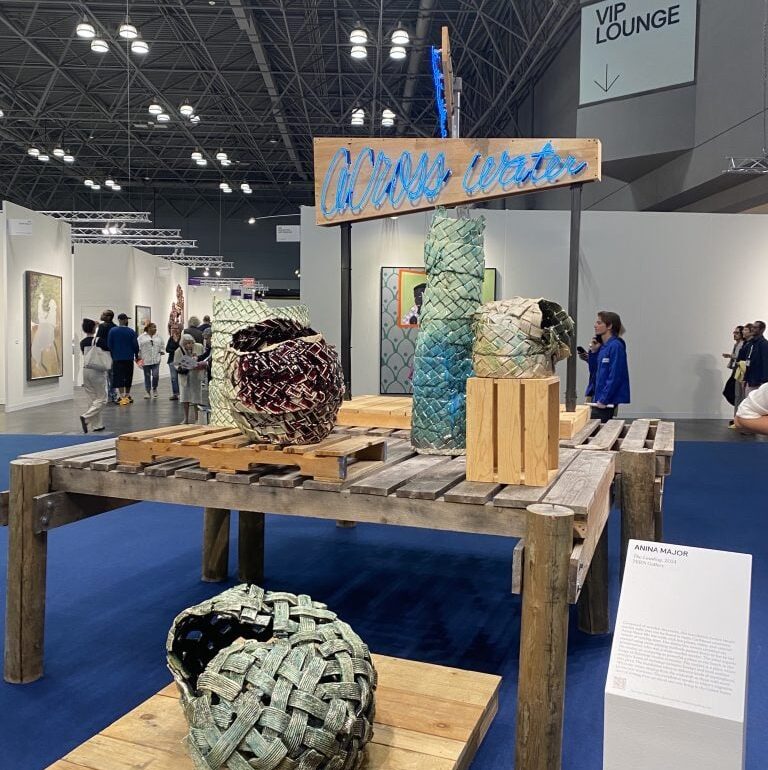06 September 2024
Art Fairs
After a quiet summer, there are signs the market is coming back to life.

The 30th edition of New York’s major annual art fair, The Armory Show, has thrown its doors open to VIP collectors for the preview day at the Javits Center, marking the fourth consecutive year at the sprawling and slightly antiseptic convention space on the far West Side of Manhattan.
It feels not only like a pivotal moment for this show but for the art fair industry as a whole. Just last summer, the Armory Show was acquired by Frieze, along with EXPO Chicago. As recently as July, just two months ago, it appointed a new director in gallery veteran Kyla McMillan, after longtime director Nicole Berry left to accept a position at the Hammer Museum in Los Angeles. Further, the run of the show coincides directly with the nascent Frieze Seoul art fair taking place on the other side of the globe right now.
All this comes amid extreme uncertainty about the global economy, stubbornly high interest rates, and what by almost all accounts from industry insiders amounts to a collector “holding pattern” ahead of the upcoming U.S. presidential election. It also comes in the wake of one of the quietest summers in recent memory in the art world business-wise.
On the other hand, crowds were out in force today. Enthusiasm and interest in the flood of art from the more than 235 exhibitors and special curated sections felt like it was robust and healthy, if far from frothy. There was a lot of chatter about how most of the major works were pre-sold far in advance of the fair. Still, today smaller works at accessible five-figure prices were a hot ticket, suggesting willingness to commit to lower asks from the galleries.
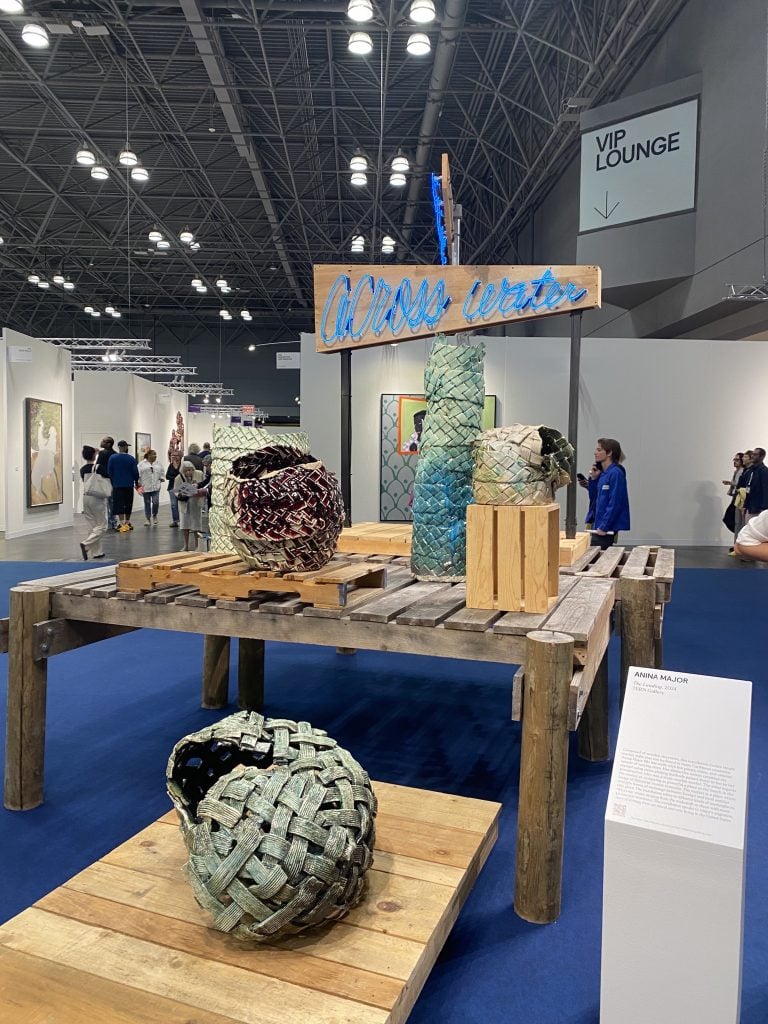
Installation view of Anina Major, The Landing (2024) at The Armory Show, New York, September 2024. Photo by Eileen Kinsella
“I came into this thinking everything would be available, but it’s not the case,” said art advisor Jessica Arb Danial. “In the U.S., there is a bit of an inflection point and a pause. And while there are transactions, they’re just taking a little bit longer. I’m okay with that,” she added.
However, the fact that two major works she had her eye on for clients were already on hold and one may have already sold did come as a surprise. (Of course, we have no way of knowing what’s actually pre-sold and what was snapped up by a buyer on day one.)
“They’re amazing works, by amazing artists and galleries. So it’s a great sign,” said Arb Danial—especially after a summer she described as really slow. “People summered hard.”
Arb Danial also said she had gone into the fair thinking that talk of a “buyer’s market” might fuel discounts. “But it’s not the case,” she told Artnet a few hours into the preview. “I feel like the dealers are persistent, and not desperate. This fair is the temperature check for the season. So far, so good.”
In the early hours of the event, I also sat down with newly minted director Kyla McMillan, who concedes that this edition of the show was pretty much locked and loaded when she took the reins just two months ago. “I’m excited to think about what our participation in the art world looks like,” she said, when asked what her goals are going forward, particularly under the new ownership structure of Frieze. “It’s definitely a moment of assessment. The only responsible thing to be doing at this point is assessing, but I certainly see potential.”
McMillian, who formerly worked at David Zwirner and Gavin Brown and founded her own platform and consultancy, Saint George Projects, said she’s excited about the mix of established and younger galleries presenting at the Armory. She mentioned the “incredible success with the pipeline” of younger galleries cutting their teeth at the fair and eventually moving up, pointing to Mariane Ibrahim, who got her start in the fair’s “Presents” section. “We look to these younger galleries not just to understand the future of this fair but what the future of the industry is.”
McMillan’s connection to the fair is also personal. “The Armory Show is the first fair that I had ever been to,” she said, remembering a friend curating the “Talks” platform when the show was held about a mile north on the Hudson River’s cruise chip piers. Unlike other gallery staffers who might grumble at the fair commitment, she says she was always “quite enthusiastic to be at art fairs and always had an interest in them. It’s an important time to look at what art fairs can do,” she added.
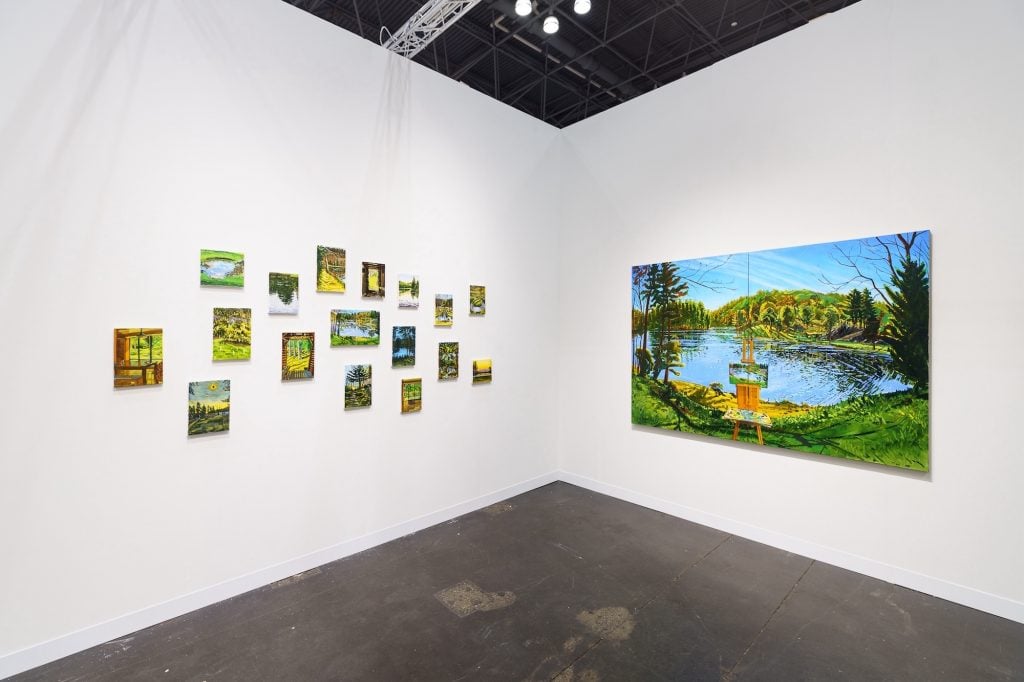
Installation view of Keiran Brennan Hinton solo show at Charles Moffett. Photo by Silvia Ros. Image courtesy the artist and Charles Moffett.
The eye-catching nature-inspired paintings by Keiran Brennan Hinton, who New York dealer Charles Moffett dedicated his solo show booth in the “Presents” section to, may just be the perfect encapsulation of what’s moving in this somewhat moody market moment. The artist created the work earlier this spring in the Hudson Valley while living and working in and around Innisfree Garden in Millbrook, New York, a 185-acre landscape that first opened to the public in 1960.
The works exemplify the artist’s plein-air discipline and skill at capturing shifting sensations of light and reflection. Moffett reported selling 10 paintings so far, in a range of sizes, with prices ranging from $5,000 to $20,000.
“It is nice to see the energy return to the city for the start of the season at the Armory,” said said Daniel Roesler, partner and senior director of Galerie Nara Roesler, which has galleries in Brazil and in Chelsea. “Tomie Ohtake has been a focus of conversation at the booth after U.S. and Brazilian collectors saw her work in Venice.”
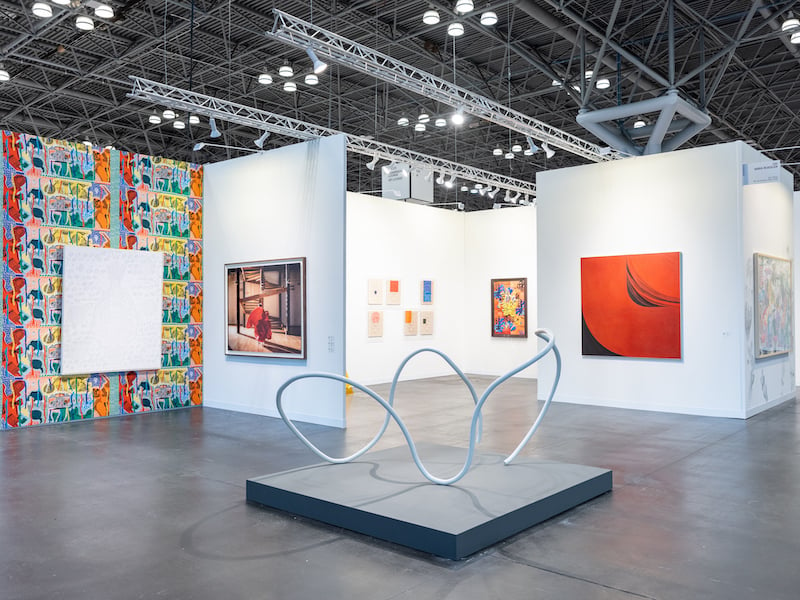
Installation view of Galerie Nara Roesler at The Armory Show, 2012. Photo by Charles Roussel. Image courtesy Galerie Nara Roesler
The gallery’s reported sales by the close of day one included: Vik Muniz’s mixed media Surfaces: Mimosa, after Matisse, (2024) for $65,000; Marco A. Castillo’s paper, fabric, and multilayer birch plywood Dictadura vertical IV, (2024), for $60,000; Elian Almeida’s painting Retirante, (2024) for $22,000; Thiago Barbalho’s Cannibal Feast, (2024) for $20,000; and Manoela Medeiros Ruína (paisagem), (2022) for $13,500.
Galerie Templon’s executive director Anne-Claudie Coric called opening day “extremely well attended, with many VIPs and curators from all over the U.S.”
Sales included a large painting by Alioune Diagne (who is representing Senegal at the Venice Biennale) to a U.S. museum, for $94,000 (€85,000), as well as a sculpture of a house by Japanese artist Chiharu Shiota for $111,000 (€100,000). Senegalese painter Omar Ba, who just moved his studio to New York, also drew interest with several sales of of small paintings on paper priced at $18,000 each.
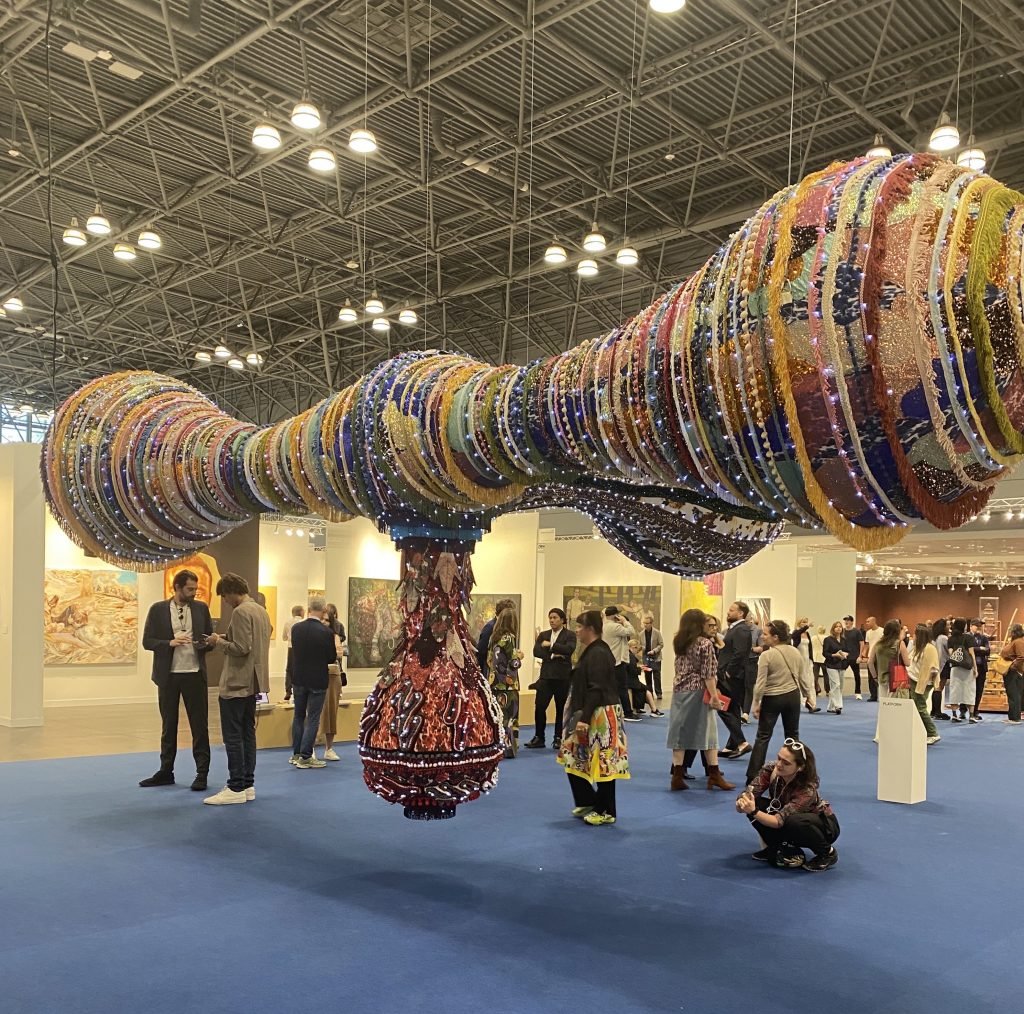
Installation view of Joana Vasconcelos, Valkyrie Liberty (2023) at The Armory Show. Photo by Eileen Kinsella.
Berry Campbell, which has carved out a dynamic niche focusing on postwar American painters—especially formerly under-appreciated Abstract Expressionist women painters—reported several solid sales. These included a newly released, never-before-seen painting from the archive of Lynne Drexler, Autumn Twilight (1977), sold for $450,000 to a private collection. And a painting by Yvonne Thomas, Blue Green (1964), sold for $125,000, while an oil on mylar by Nanette Carter, titled Cantilevered #14, (2014), was reportedly whisked away for $22,000.
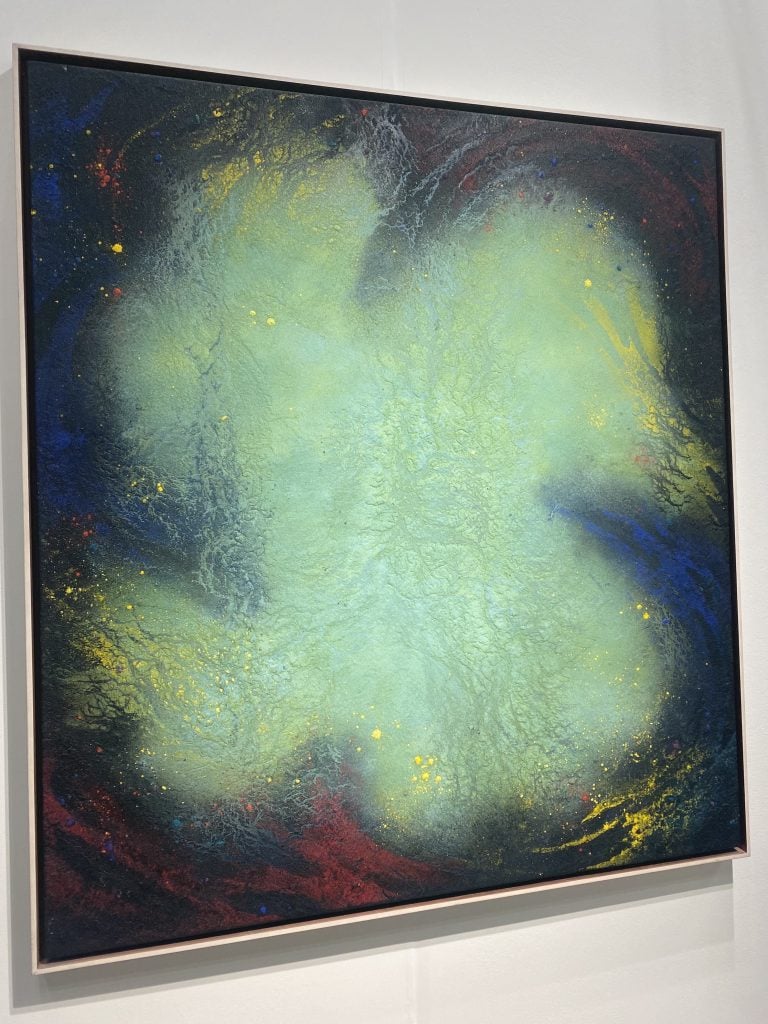
Installation view of Natvar Bhavsar at DAG at The Armory Show, New York, September 2024. Photo by Eileen Kinsella
Speaking of established names: DAG gallery devoted its entire booth to a career-spanning survey of Natvar Bhavsar, showcasing more than 20 works spanning 50 years of the artist’s career. Bhavsar, who turned 90 a few months ago, continues to paint on a daily basis in his New York City studio. He arrived in New York in 1965 and gained recognition alongside other Abstract Expressionists stars, and was actually on hand at the fair to see the survey and greet visitors and collectors.
“The energy on the first day has been great,” said veteran exhibitor Sean Kelly. “It’s always exciting to see the meaningful connections being made between our artists’ work and collectors, curators, and the enthusiastic art audience. We’ve had a great response to our booth selling multiple works by Jose Dávila, Sam Moyer, Ilse D’Hollander, Hugo McCloud, Janaina Tschäpe, and Brian Rochefort, amongst others. We have a number of ongoing conversations and are looking forward to the remainder of the fair being strong.”
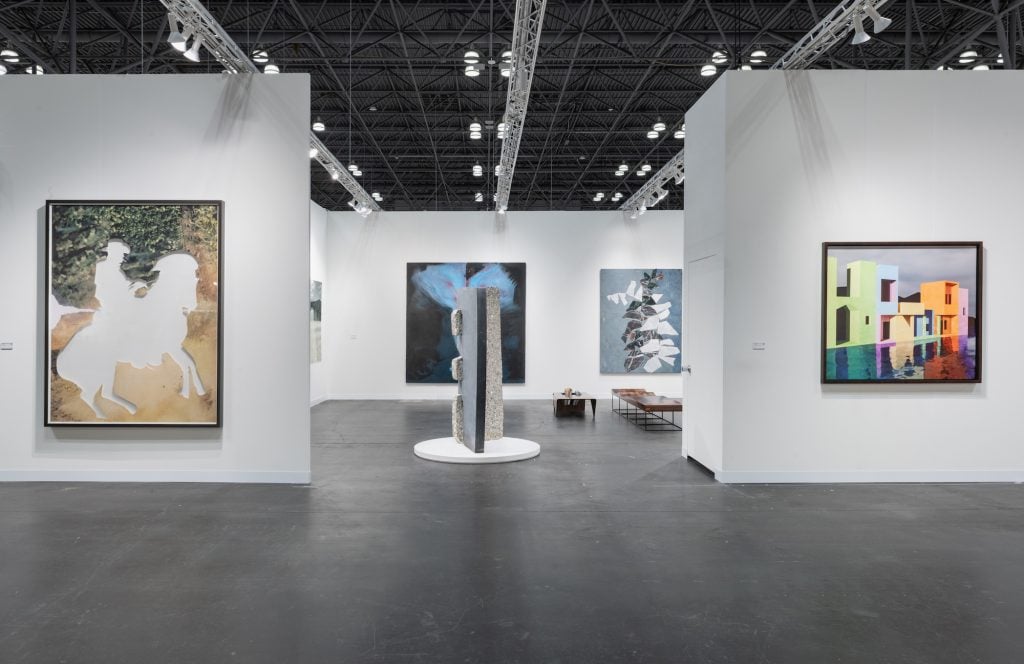
Installation view of Sean Kelly’s booth at The Armory Show, New York, September 2024. Photo by Adam Reich. Image courtesy Sean Kelly Gallery.
Among the reported sales was Dávila’s Untitled (Cowboy), (2023), an archival pigment print for $65,000; several paintings by Hugo McCloud including blessing of the hands 1, (2024) for $45,000; Untitled, (2024) for $30,000; Sam Moyer’s Compound Fern (2024) for $70,000; and Ilse d’Hollander’s Untitled (1995) for $61,000 (€55,000).
Additional sales rumors: Robert Motherwell’s Apse (1980-1984) for $825,000 and Walton Ford’s The Singer Tract (2023) for $750,000, sold by Kasmin; an Ai Weiwei cast bronze work for $450,000, sold by Tang Contemporary Art; a charcoal artwork by Korean-artist Lee Bae for $300,000 at Johyun Gallery; two Doug Aitken lightboxes for $275,000 and $150,000 at 303 Gallery; and a painting by Nir Hod for $140,000 at Michael Kohn.
The Armory Show continues at the Javits Center, through September 8, 2024.
Follow Artnet News on Facebook:
Want to stay ahead of the art world? Subscribe to our newsletter to get the breaking news, eye-opening interviews, and incisive critical takes that drive the conversation forward.
More Trending Stories
This post was originally published on this site be sure to check out more of their content



